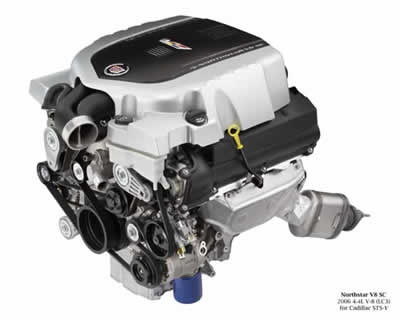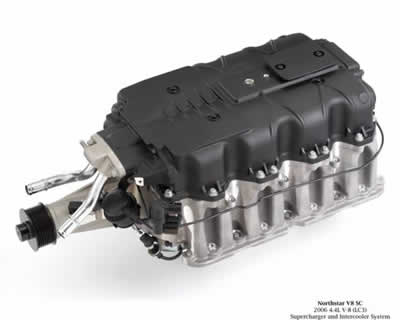
|
 |
|
Last Updated: Aug 28th, 2006 - 01:36:21 |

2006 CADILLAC STS-V: ENGINE
GM UNLEASHES NORTHSTAR 4.4-LITER SUPERCHARGED V-8 FOR 2006 CADILLAC STS-V
|
|
Most output ever for any production Cadillac |
|
|
440 horsepower / 430 lb.-ft. torque |
|
|
100 horsepower per liter power density |
|
|
First supercharged production engine for Cadillac |
|
|
Engineered to combine high performance with superior level of refinement |
DETROIT - GM is introducing a new, 4.4-liter supercharged version of the Northstar power plant engineered to deliver an advanced level of performance and refinement that will power Cadillac's all-new 2006 luxury performance flagship, the STS-V. The Northstar V-8 SC (supercharged) churns out 440 horsepower (328 kW) at 6400 rpm and 430 lb.-ft. (583 Nm) of torque at 3600 rpm (power and torque figures estimated) - and the effortless might of the supercharged Northstar V-8 SC is underscored by its ability to deliver 90 percent of its peak torque between 2200 and 6000 rpm. The Northstar V-8 SC generates 120 horsepower (90 kW) and 115 lb.-ft. (156 Nm) of torque more than its naturally aspirated counterpart, while its specific output of 100 horsepower per liter makes it one of the world's most power-dense production V-8 engines.
But the Northstar V-8 SC isn't just a power story. The Northstar V-8 SC was developed from the start to compete with the world's finest luxury-performance powerplants. GM Powertrain engineers designed and developed a host of revisions and upgrades that markedly improve upon the already high degree of refinement found in the naturally aspirated Northstar. In fact, many of the engine's numerous new features and components simultaneously help to increase power output and reduce noise, vibration and harshness (NVH).
"This is the first supercharged Cadillac production engine," said Donna Haiderer, assistant chief engineer, Northstar engines. "If it is going to be a Cadillac, it has to be refined. It is critical to have exceptional smoothness and driveability to go along with the extreme power."
Supercharging First for Northstar
 |
| The Complete 440 Horsepower Northstar SC Found Under the Hood of the STS-V |
The supercharged variant of the Northstar is far more than a naturally aspirated Northstar fitted with a supercharger. In a rapid development process, GM Powertrain engineers undertook a systems approach to ensure the Northstar V-8 SC met, and often exceeded, the high power, refinement, durability and fuel economy targets required for the luxury-performance market.
"The naturally aspirated Northstar 4.6L V-8 VVT (variable valve timing) launched last year gave us an outstanding foundation to start from," said Haiderer. "It helped us to more quickly develop a better engine."
Nonetheless, about half of the Northstar V-8 SC components are new or heavily revised from those of the standard rear-wheel-drive/all-wheel-drive Northstar V-8 VVT introduced in the 2004 Cadillac XLR and SRX, including every major structural component on the engine. The new Northstar V-8 SC retains the 90-degree "V" angle and DOHC, four-valves-per-cylinder layout of the naturally aspirated versions. The continuously variable valve timing system for both intake and exhaust valves from the Northstar V-8 VVT also has been carried over, but with a specific valve timing strategy optimized for this boosted application. Because supercharging places more stress on the engine structure - while yielding higher output from a smaller displacement - cylinder bore size for the Northstar V-8 SC is reduced to 91 mm from the naturally aspirated engine's 93 mm. Stroke remains the same 84 mm for both engines, resulting in a displacement of 4.4 liters for the new supercharged engine, slightly smaller than the 4.6-liter displacement of all Northstars since the 1993 model year introduction. This reduction in displacement also helps to offset the fuel economy impact of the supercharger and its associated lower compression ratio. The Northstar V-8 SC has a 9.0:1 compression ratio, compared with the 10.5:1 for the naturally aspirated 4.6-liter Northstar. The supercharged Northstar's painstaking engineering "balance" amounts to speak-softly refinement and carry-a-big-stick power.
Not Your Father's Supercharger
The heart of the new Northstar V-8 SC is, of course, its supercharger system. Once it was decided to enhance the naturally aspirated Northstar via forced induction, engineers had to decide between three options: turbocharging, supercharging with the well-established Roots-type supercharger, or supercharging with a screw-type supercharger.
 |
| All New Patented GM Roots Blower Found Atop the Northstar SC |
Turbocharging was ruled out because all turbocharged engines experience some degree of turbo "lag," a brief pause between when the throttle pedal is depressed and when the turbocharger actually begins producing a meaningful amount of boost. That left the decision between a screw-type supercharger and the Roots design. Engineers decided against the screw-type supercharger because the design is less fuel-efficient in part-load conditions. Equally important, screw-type compressors require noisy clutches that also can cause driveline disruptions - neither of which was acceptable for the Northstar V-8 SC's high NVH targets. The Roots boosting approach eliminated any perceptible lag while avoiding the refinement and cruising fuel economy concerns associated with screw-type superchargers.
"The Northstar V-8 SC has tremendous reserve, particularly apparent in situations that can have naturally aspirated V-8s searching for power," said Greg Prior, Northstar V-8 SC project manager. "Put your foot down with the Northstar V-8 SC and you experience instantaneous throttle response - the feeling is one of immediate 'large displacement.'"
GM Powertrain engineers conceived and co-developed a new, larger and more efficient rotor set to use with the GM patented supercharger in conjunction with Eaton Corp. The unique new "high twist" rotors that enhance airflow and charge density are a GM design unavailable from any other automaker. This new design is the core of a systems-engineering approach that also includes the unique water-to-air "tubular" intercoolers and all-new intake system.
Northstar Architecture Enhanced for Supercharging
Although the supercharger system is the most visible modification to the new Northstar, there are numerous components that are totally new or redesigned to deliver the performance, durability and refinement required for the supercharged application. Some of the most important enhancements for the Northstar V-8 SC include:
 |
Structure |
|
Revisions to the structure include the all-new precision sand-cast aluminum cylinder block with semi-closed deck, improved water-jacket flow, new oil gallery to supply piston-cooling jets, improved material properties and structural ribbing. The new block also adopts the revised 91-mm bore (standard Northstar: 93-mm bore). These changes provide enhanced durability and extra refinement for the high-performance Northstar V-8 SC. The new cylinder heads have structural upgrades with new combustion chambers and copper-infiltrated intake-valve seats. Special multi-layer steel (MLS) head gaskets are employed due to the higher combustion pressure of the Northstar V-8 SC. All-new, heavy-duty pistons are designed for the high pressures and temperatures under boost. Connecting rods are a revised design, heat-treated powder metal and feature a 24-mm pin bushing to withstand higher pressures. The forged-steel crankshaft was new for the naturally aspirated Northstar upgrade in '04 and is carried over with minor revisions for balancing with the new pistons and rods. |
 |
Electronic Controls |
|
The Northstar V-8 SC uses a new E67 engine control module (ECM) to meet the processing demands posed by the variety of interfacing subsystems. The E67 is the most powerful ECM currently used by GM. The ECM boasts 32-bit processing power and incorporates 36 kilobytes of internal RAM, 128 kilobytes of external RAM, 2 megabytes of burst flash memory and a high-speed CAN bus for optimal networking capability. The electronic throttle control (ETC) has vehicle speed-based calibration to enhance throttle response and driver interface. |
 |
Airflow |
|
The GM-unique increased displacement supercharger rotors and GM-patented integral supercharger module work as a system to provide high airflow. The air cleaner and mass airflow sensor offer new, lower-restriction designs, while the throttle body has a straight bore to reduce restriction and turbulence. Special Laminova intercoolers increase intake-charge flow and density and also help suppress noise. The four-cam variable valve timing is controlled by the ECM with a cam timing strategy specific to the supercharged engine that optimizes performance, fuel economy and idle quality. The supercharged Northstar also has new camshaft profiles and exhaust systems specific to the boosted applications to improve flow. Extrudehone exhaust-port polishing on the Northstar V-8 SC cylinder heads improves exhaust flow and power. This automated process performs a "port and polish" job on all exhaust ports in a consistent manner. |
 |
Lubrication |
|
The lubrication system features a higher-output oil pump and high-flow oil filter. The system also incorporates piston-cooling jets that direct oil to the underside of each piston, helping to raise the knock threshold, which increases power and high-speed fuel economy. The jets also enhance NVH by damping the piston, bore and pin interfaces. The lubrication system was developed to deliver adequate flow under extreme driving conditions and, like every aspect of Northstar V-8 SC performance, was validated with GM Powertrain's standard tests and in high-speed testing at the demanding Nürburgring race track. |
 |
Accessory Drive |
|
Much of the Northstar V-8 SC accessory drive system is new, largely because of the need to drive the supercharger. The crank pulley drives three belts including the new dedicated supercharger drive belt. |
Proven and refined
The Northstar V-8 SC development process included severe real-world testing at Milford Proving Ground in Mich., and Desert Proving Ground in Ariz.; Pahrump Valley Speedway, Nev.; Kapuskasing, Ontario; Denver, Colo.; and Nürburgring, Germany. At such locations and under extreme conditions, the final engine calibrations are developed. Thermal performance is simultaneously optimized, assuring that intercooler, engine coolant, engine oil, transmission fluid and final drive temperatures are all controlled to allow continuous heavy-duty operation. Only after adjusting and refining under these grueling conditions is the engine proven ready for production. Many hours of dynamometer testing using GM's own engine durability tests further validate the thermal and structural integrity of the engine design. Many of these tests were adapted specifically for this intercooled engine.
Discuss this article on AutomotiveForums.com
© Copyright 2006 by AutomotiveArticles.com
Top of Page
|
|
 |
|

 AF Project Vehicle | Corporate
AF Project Vehicle | Corporate



 AF Project Vehicle | Corporate
AF Project Vehicle | Corporate

